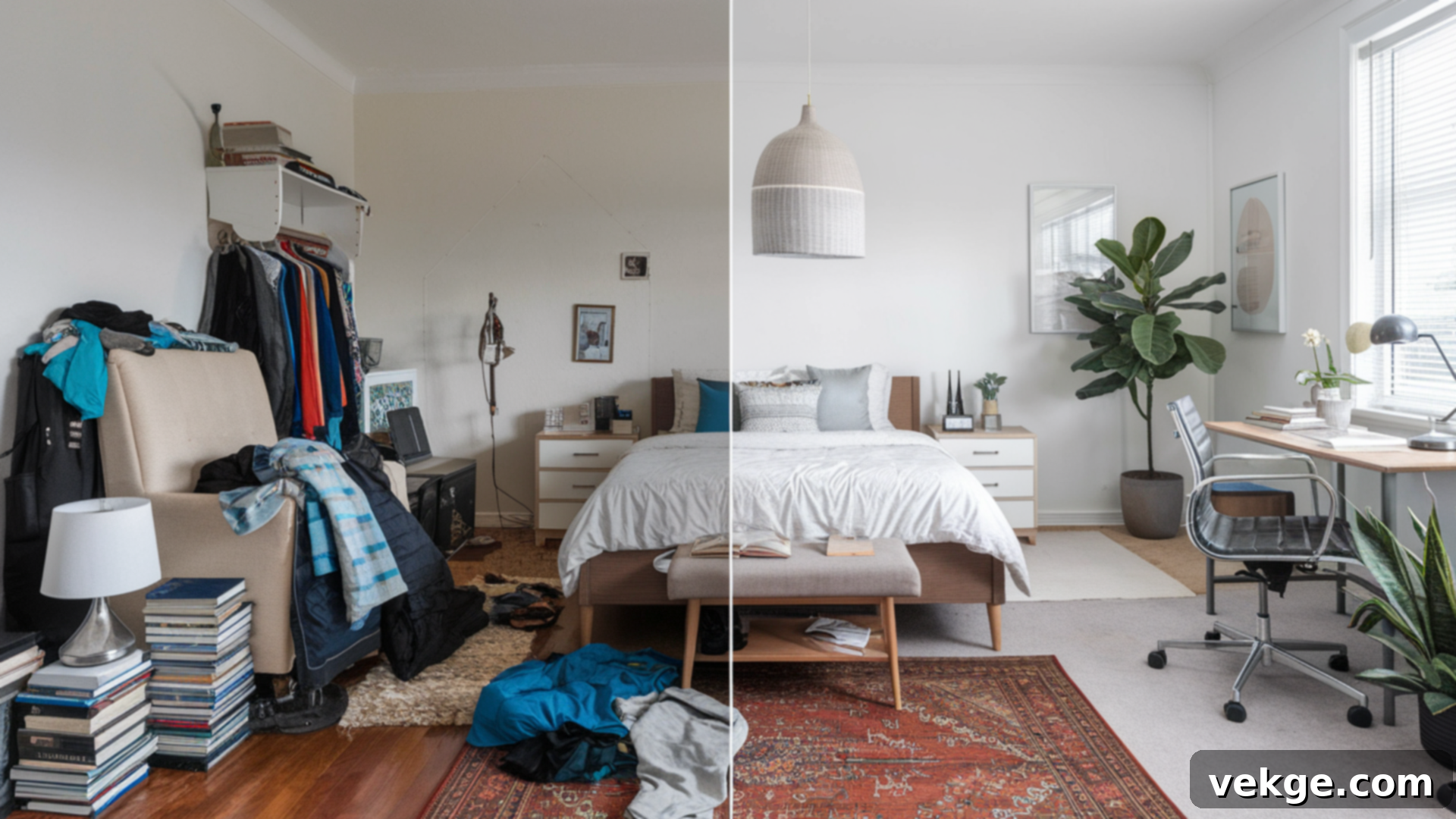Declutter Your Life: The Ultimate Room-by-Room Checklist for a Calm and Organized Home
Does your living space often feel overwhelmed by clutter? It’s a common experience – a chaotic environment can quickly erode your peace of mind, making it challenging to focus, relax, or truly enjoy your home. But here’s the good news: you’re not alone, and reclaiming control over your space is far more achievable than you might think.
This comprehensive guide will walk you through a simple yet powerful decluttering checklist, designed to help you systematically clear out the mess without feeling overwhelmed. We’ll break down the process step by step, providing clear instructions and actionable strategies for deciding what to keep, what to donate, and what to discard.
Whether you’re tackling a cluttered bedroom, a chaotic kitchen, a busy home office, or even an overflowing garage, by the end of this article, you’ll be equipped with the tools and motivation to create a cleaner, calmer, and more inviting sanctuary. Get ready to transform your surroundings and, in doing so, simplify your life.
How a Decluttering Checklist Can Revolutionize Your Life
Decluttering is much more than just tidying up; it’s a pathway to a simpler, more organized, and ultimately more fulfilling life. A well-structured decluttering checklist serves as your personal roadmap, guiding you through the process, ensuring no area is overlooked, and empowering you to maintain control over your belongings.
Beyond simply tidying, decluttering offers profound benefits: it reduces stress, frees up mental energy, saves valuable time spent searching for items, and allows you to focus on what truly matters. When your physical space is clear, your mind often follows suit, leading to increased productivity, improved relaxation, and a greater sense of well-being.
Effective decluttering often incorporates proven methods that streamline decision-making and prevent future accumulation. For instance, the “One In, One Out” rule encourages balance by ensuring that for every new item you acquire, an old one departs. The renowned KonMari Method, popularized by Marie Kondo, transforms the process into a joyful journey of keeping only items that “spark joy,” fostering a deeper connection with your possessions.
Another practical approach is the 4-Box Technique, which simplifies sorting by categorizing items into “keep,” “donate,” “sell,” or “toss” boxes, making decisions quick and definitive. These techniques, when integrated with your personalized decluttering checklist, empower you to systematically free up valuable space not just in your home, but also in your mind. By adopting these strategies, you’ll embark on a journey towards a less stressful, more efficient, and profoundly more joyful living experience.
Proven Decluttering Methods to Simplify Your Journey
Embarking on a decluttering journey doesn’t have to be overwhelming. By understanding and applying these tried-and-true methods, you can approach the task strategically and maintain an organized, stress-free home with the help of your declutter your home checklist:
1. The “One In, One Out” Rule
The “One In, One Out” rule is a fundamental principle for maintaining balance in your home. Its premise is simple yet powerful: every time you bring a new item into your living space, you must let go of one existing item. This method acts as a proactive defense against clutter, preventing it from accumulating in the first place.
By consistently applying this rule, you’ll not only keep your space tidy but also cultivate a more mindful approach to shopping and acquiring new possessions. It encourages you to evaluate each potential purchase and existing item, ensuring that everything you own truly adds value without overwhelming your environment. This practice helps avoid that familiar feeling of being swamped by unnecessary belongings.
2. The KonMari Method
Developed by Japanese organizing consultant Marie Kondo, the KonMari Method transcends simple organization; it’s a philosophy centered on finding joy in your possessions. This method encourages you to keep only the items that “spark joy”. Instead of decluttering by room, Kondo recommends tackling categories of items – starting with clothes, then books, papers, komono (miscellany), and finally sentimental items – gathering everything from that category in one place before making decisions.
The core of this method involves holding each item and asking yourself if it truly brings you happiness. This approach fosters a deeper emotional connection with your belongings, making it easier to part with items that no longer serve a purpose or bring you joy. The result is a home filled exclusively with things you love and value, leading to a profoundly peaceful, organized, and inspiring environment.
3. The 4-Box Technique
The 4-Box Technique is an incredibly effective and straightforward method for decluttering. It simplifies the decision-making process by having you sort items into four distinct categories: keep, donate, sell, and toss. This action-oriented approach helps clarify what needs to be done with each item you encounter.
As you move through your space, designate four physical boxes or areas for these categories. Pick up each item, make a quick decision about its fate, and immediately place it into the appropriate box. The beauty of this method lies in its efficiency; it reduces hesitation and promotes swift action, allowing you to quickly remove what no longer serves you from your immediate environment. This technique streamlines the decluttering process, making it easier to stay focused and minimize clutter effectively.
4. The 12-12-12 Rule
Perfect for those who feel overwhelmed by the sheer volume of items, the 12-12-12 Rule offers a refreshingly simple and manageable approach to decluttering. This technique involves committing to finding 12 items to toss, 12 items to donate, and 12 items to put back in their proper place during a single, short session.
By breaking down decluttering into these small, concrete steps, the task becomes far less daunting. It allows you to make noticeable progress quickly, without dedicating hours to the process. This method is incredibly easy to follow and is ideal for busy individuals or anyone looking for consistent, small actions that contribute to keeping their space organized and clutter-free over time.
5. The 90/90 Rule
The 90/90 Rule is an excellent tool for evaluating the true utility of your possessions, particularly those you’re hesitant to part with. This rule encourages you to ask two critical questions about an item: Have I used this item in the last 90 days? And will I use it in the next 90 days? If the honest answer to both questions is no, it’s likely time to let that item go.
This pragmatic rule helps you focus on keeping only useful or necessary items, challenging sentimental attachments to things that no longer serve a practical purpose in your current life. It cuts through indecision, making it significantly easier to release items that are simply taking up space, freeing you to enjoy a more functional and intentional living environment.
6. The 1-3-5 Method
The 1-3-5 Method is a powerful organizational strategy that helps you prioritize and manage your decluttering tasks effectively, especially when faced with a wide range of chores. It breaks down your to-do list into three categories: one big task, three medium tasks, and five small tasks.
This method encourages you to identify and tackle tasks based on their size and importance, ensuring a balanced approach to decluttering. By completing these tasks in order – starting with the big task, then moving to the mediums, and finishing with the smalls – you’re able to achieve steady progress and prevent the overwhelming feeling that often accompanies large projects. This structured approach keeps your decluttering efforts organized, manageable, and highly effective, allowing you to incrementally conquer even the largest projects over time.
Your Room-by-Room Home Checklist to Declutter Your Space
Feeling overwhelmed by the prospect of decluttering your entire home? These specific checklists, broken down by room, are designed to transform the daunting task into a series of simple, manageable actions. Tackle one area at a time and witness the incredible transformation!
Decluttering Checklist for a Living Room
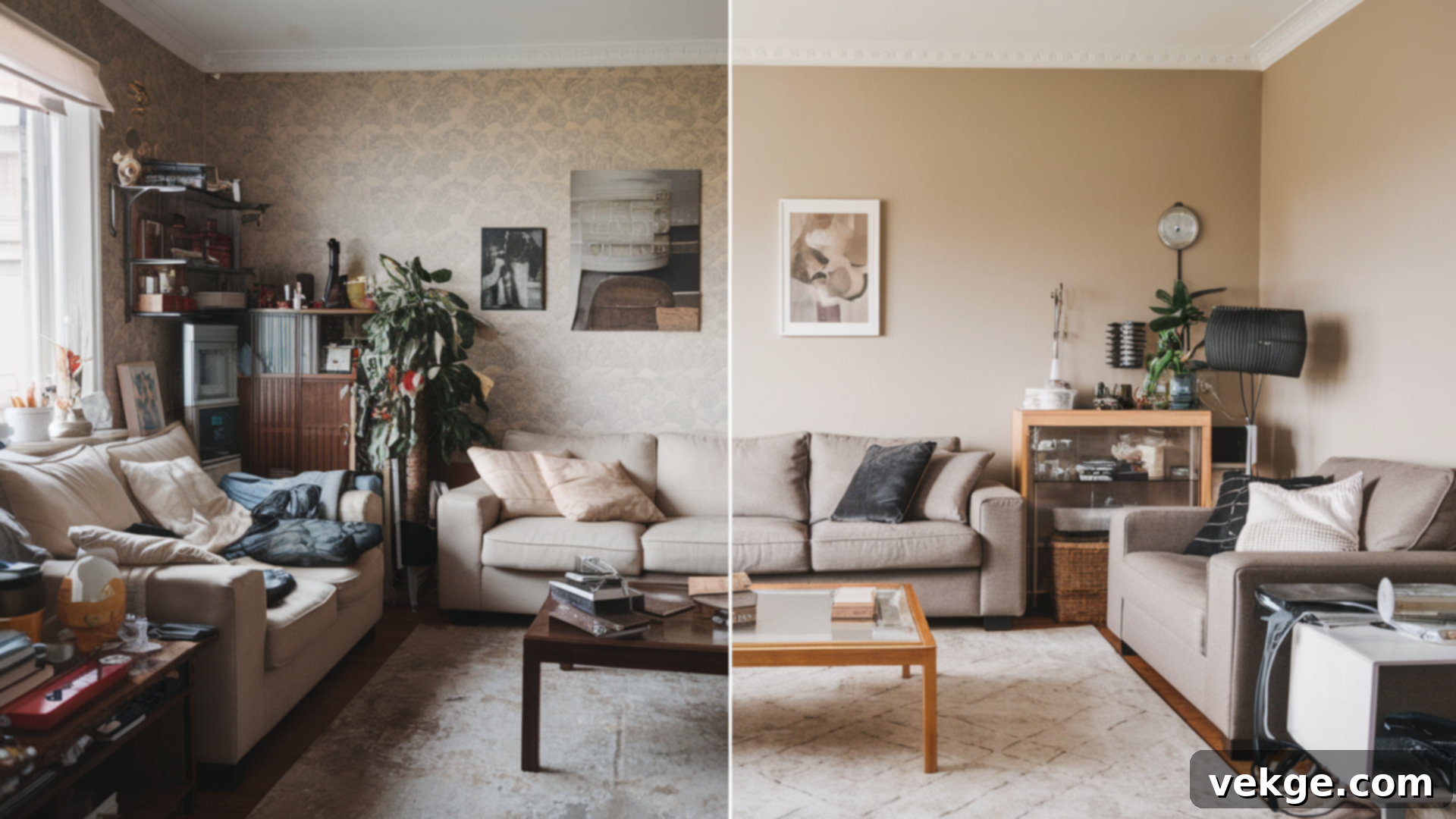
Your living room is often the heart of your home, a place for relaxation and connection. A tidy, well-organized living room can instantly make your entire space feel more inviting and serene. Use this comprehensive checklist to systematically organize your main living area, creating a cozy, clutter-free environment where you can truly unwind:
- Clear All Surfaces: Begin by systematically removing all non-essential items from horizontal surfaces like coffee tables, side tables, and shelves. Prioritize items that don’t belong or are rarely used, such as old magazines, scattered remote controls, or forgotten decorative pieces. Wiping down these cleared surfaces immediately creates a visual sense of calm and space.
- Sort Through Cushions and Throws: Gather all extra blankets and decorative pillows. Fold or store those you wish to keep neatly in a basket or storage ottoman. Critically evaluate any that are worn out, faded, or no longer match your décor, and decide to donate, repurpose, or discard them.
- Organize Electronics and Cords: Untangle and tidy up charging cables, remotes, and other electronic accessories. Invest in cord organizers, cable ties, or small decorative boxes to conceal them. Consolidate remotes into a single, accessible container or drawer to reduce visual clutter.
- Declutter Bookshelves and Media: Go through your book collection, keeping only those you truly love, reference often, or intend to read soon. Donate or sell books you no longer need. For DVDs, CDs, or video games, remove any that are outdated or unplayed. Dust the shelves thoroughly for a clean, fresh appearance.
- Check Furniture Surfaces: Take a moment to remove anything that doesn’t belong on your sofa, armchairs, or other furniture. This often includes forgotten cups, dishes, mail, or random trinkets. Ensuring furniture is clear allows for comfortable use and a neater overall look.
- Tidy Up Decorative Items: Evaluate your décor pieces. Keep decorations minimal and meaningful. Remove anything that feels excessive, adds to visual clutter, or no longer aligns with your living room’s aesthetic. Less is often more when it comes to creating a peaceful atmosphere.
- Clean Out the Entertainment Center: If you have an entertainment center, open its doors and drawers. Remove old electronics, unused accessories, and any obsolete media. Organize the remaining items logically, ensuring that everything you need is easy to access without creating a mess.
- Declutter Hidden Storage Spaces: Don’t forget to check inside side tables, cabinets, or storage ottomans. These often become catch-all zones for items you rarely use. Ruthlessly remove what’s no longer needed, then categorize and neatly store the remaining essentials.
- Rearrange Furniture for Flow: Consider if your furniture layout enhances or hinders the room’s flow. Adjust pieces to create clear pathways and an open, inviting atmosphere. Sometimes a small shift can make a big difference in how spacious and comfortable a room feels.
- Perform a Final Touch-up: Once the decluttering is complete, give the room a thorough clean. Vacuum or sweep the floor, wipe down all surfaces with a damp cloth, and make any final adjustments to furniture and décor. Enjoy your newly organized and tranquil living space!
Decluttering Checklist for a Kitchen
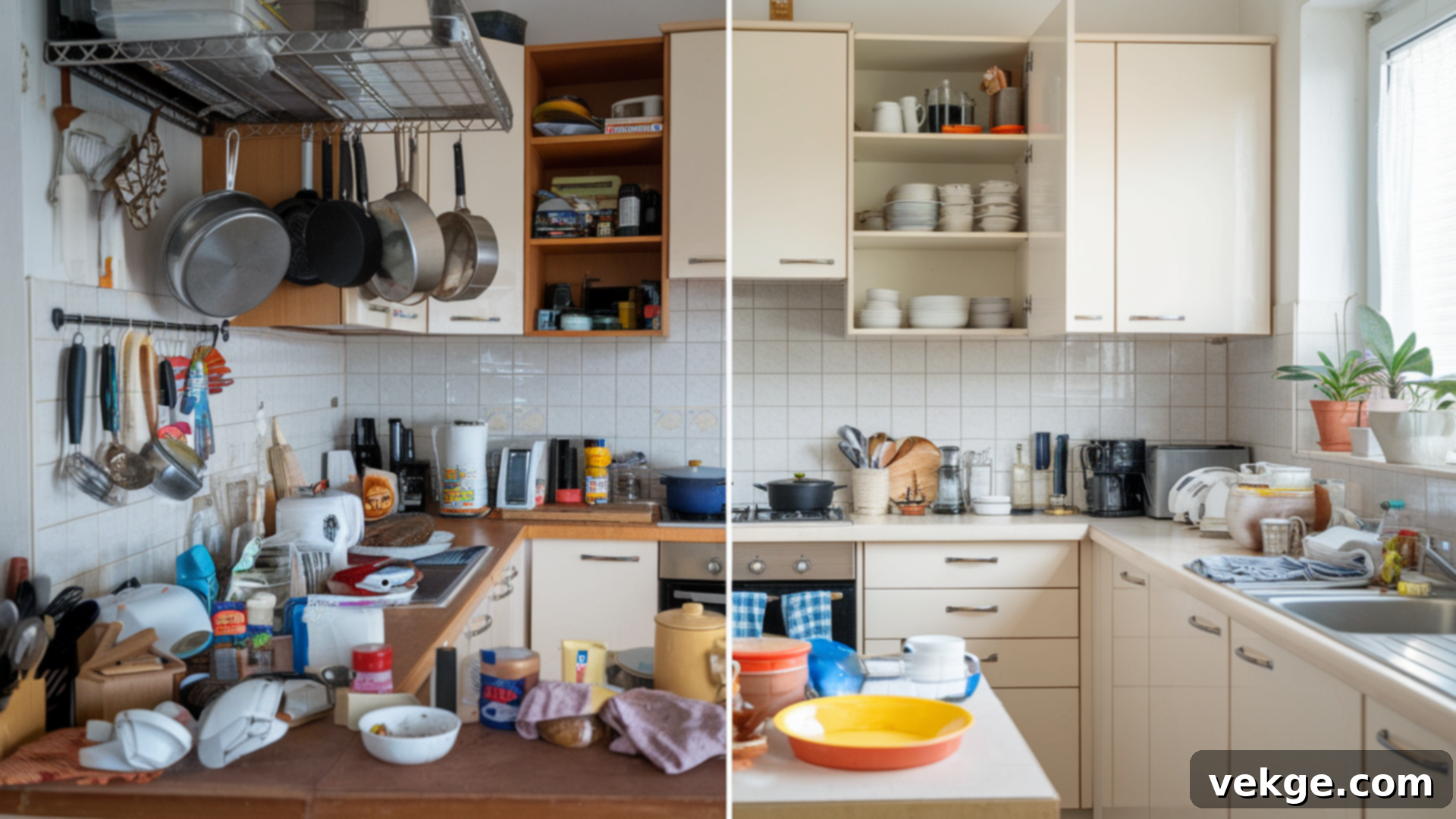
An organized kitchen is the cornerstone of an efficient and enjoyable home. When your kitchen is streamlined, meal preparation becomes easier, cooking is more pleasurable, and maintaining cleanliness is a breeze. Use this essential checklist to systematically declutter your culinary space, making it simpler to find what you need and sustain a welcoming order:
- Clear Countertops: Start by removing all non-essential items from your kitchen counters. This includes rarely used appliances, food packaging, or random items that tend to accumulate. Keep only frequently used appliances and essential tools within easy reach to maximize workspace and visual appeal.
- Sort Through Your Pantry: Systematically check expiration dates on all food items. Dispose of anything expired, stale, or unused. Organize the remaining items by category (e.g., grains, canned goods, snacks) and consider using clear containers or bins to keep everything visible and accessible.
- Declutter Cabinets and Cupboards: Go through your dishes, cups, bowls, and serving ware. Donate or discard any items that are chipped, cracked, duplicated, or rarely used. Keep only practical, functional, and aesthetically pleasing pieces that you regularly enjoy using.
- Organize Drawers: Tackle your utensil and gadget drawers. Remove duplicates, broken items, or tools you haven’t used in years. Utilize drawer dividers or trays to create designated spots for everything, ensuring a neat and highly functional system.
- Clean the Refrigerator and Freezer: Remove all food items from your fridge and freezer. Dispose of expired condiments, forgotten leftovers, and anything that looks suspicious. Wipe down all shelves, drawers, and interior surfaces. Organize remaining food with similar items together for easy visibility and access.
- Sort Cleaning Supplies: Gather all your kitchen cleaning products. Dispose of empty bottles, outdated solutions, or cleaning tools that are worn out. Store the necessary items in a designated, easy-to-reach area, perhaps under the sink or in a utility cabinet.
- Check Under the Sink: This area often becomes a dumping ground. Remove all items from under the sink. Discard old sponges, broken buckets, or cleaning products you no longer use. Wipe down the area and place a protective liner before organizing the remaining essentials neatly.
- Organize Cooking Tools and Bakeware: Go through your pots, pans, baking sheets, and casserole dishes. Donate or toss any items that are warped, damaged, or haven’t been used in over a year. Keep only the high-quality, functional pieces you consistently use for cooking and baking.
- Declutter the “Junk Drawer”: If you have a designated junk drawer, now is the time to tackle it. Empty everything out. Sort through miscellaneous items like batteries, rubber bands, old receipts, and pens. Toss what’s no longer useful and organize the rest using small dividers.
- Perform a Final Touch-up Clean: After the decluttering is complete, give your entire kitchen a sparkling finish. Wipe down all counters, cabinet fronts, the exterior of the fridge, and the stove. Ensure every item has its designated place, leaving you with a fresh, organized, and inviting kitchen.
Decluttering Checklist for a Bedroom
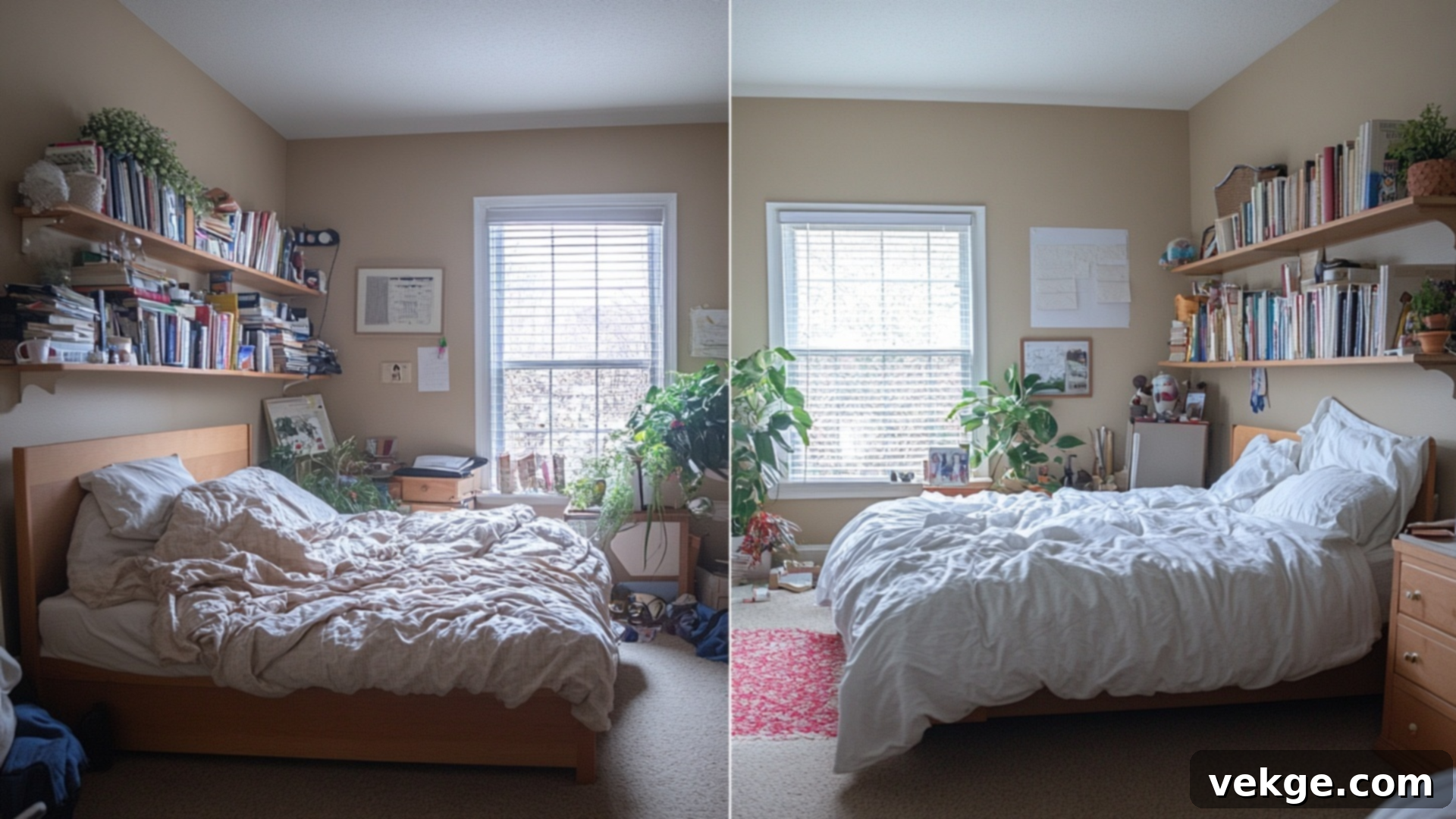
Your bedroom should be a personal sanctuary, a space for ultimate relaxation and restorative sleep. Clutter in this area can significantly disrupt your ability to unwind and achieve peaceful rest. By following this detailed checklist, you can transform your bedroom into a neat, comfortable, and truly serene retreat:
- Clear the Bed and Bedside Area: Start by making your bed, then remove anything that doesn’t belong on it – clothes, books, stray dishes, or miscellaneous items. A made bed instantly creates a sense of order.
- Sort Through Clothes (Closet & Drawers): This is a major area for clutter. Go through every item in your closet and dresser drawers. Employ the “spark joy” method or the 90/90 rule. Donate, sell, or discard any clothes that don’t fit, are worn out, or haven’t been worn in a long time. Organize remaining items by type or color for easy access.
- Organize Nightstands: Clear off your nightstands completely. Remove old receipts, random papers, unused electronics, or forgotten accessories. Keep only the essentials you use daily, such as a lamp, an alarm clock, your current book, and perhaps a glass of water.
- Declutter Under the Bed: This hidden zone often accumulates forgotten items. Pull out any storage bins or loose items. Evaluate each item; remove anything unnecessary, broken, or unused. Optimize under-bed storage for seasonal items or infrequently accessed linens.
- Sort Through Personal Items & Accessories: Gather all your jewelry, watches, belts, scarves, and other personal accessories. Donate or toss items that are broken, outdated, or rarely worn. Organize the keepers in proper organizers to prevent tangles and make selections easier.
- Tidy Up Dresser Drawers: Beyond clothes, check any other dresser or bedside table drawers. Neatly fold or arrange clothes, and ensure any other items stored there are purposeful and organized. Remove anything that creates unnecessary bulk or mess.
- Clean Out the Entire Closet: After clothes, focus on the structural organization of your closet. Arrange shoes neatly, hang clothes by category (shirts, pants, dresses), and consider utilizing shelves or bins for accessories. Keep only what you genuinely need and love, ensuring easy retrieval.
- Clear All Horizontal Surfaces: Beyond your nightstand, dust and wipe down all other surfaces, including dressers, shelves, and window sills. Remove any unnecessary knick-knacks, souvenirs, or décor that contribute to visual noise.
- Sort Through Books or Magazines: Collect all books and magazines in your bedroom. Donate, recycle, or sell any you no longer need or intend to read. Keep only your current reads or cherished favorites neatly arranged.
- Perform a Final Touch-up: Once decluttering is complete, vacuum or sweep the floor thoroughly. Arrange your furniture neatly, adjust lighting, and add any final touches like fresh flowers to make your bedroom feel truly calm, organized, and welcoming for rest.
Decluttering Checklist for a Home Office
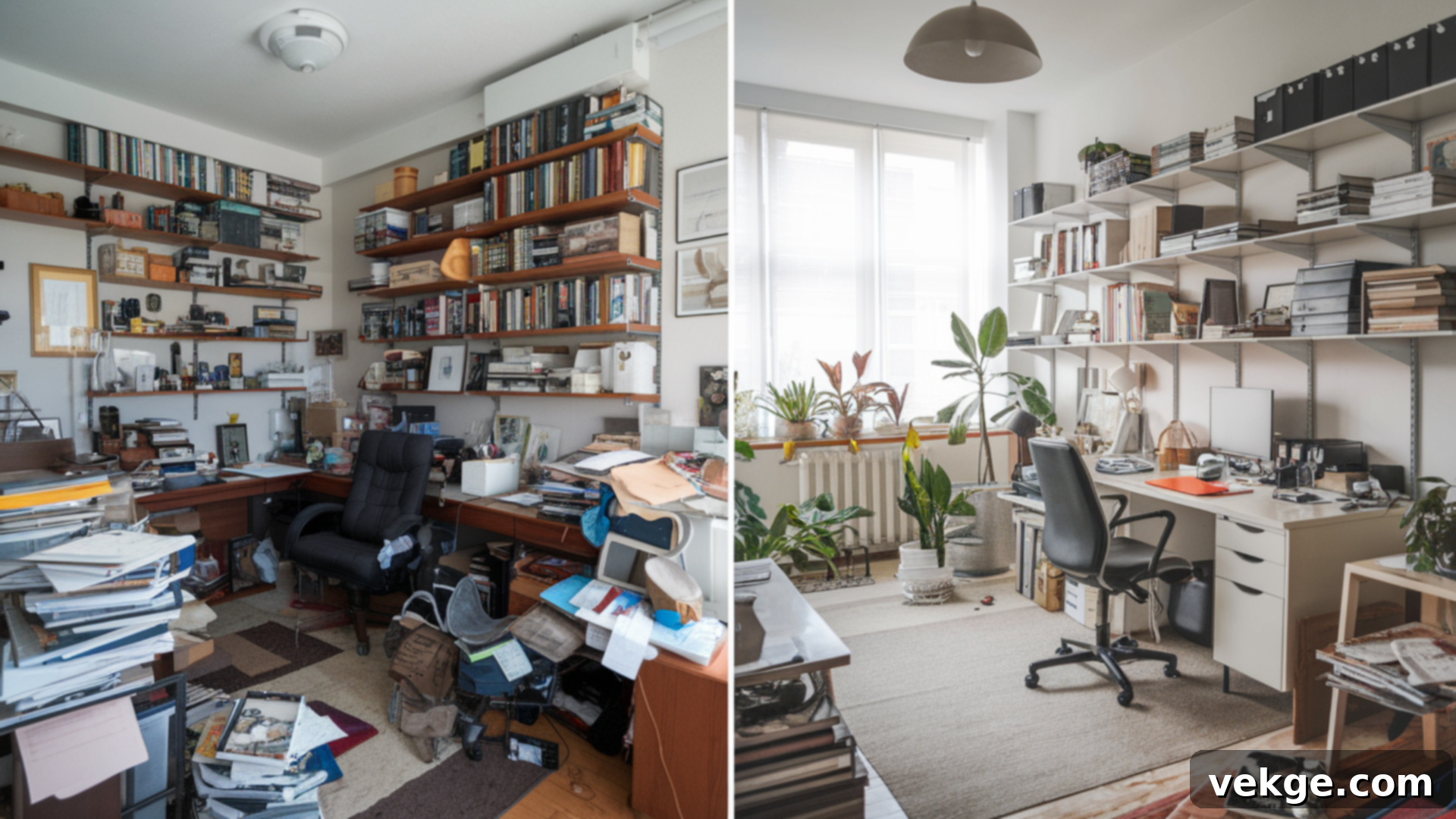
A well-organized home office is crucial for productivity, focus, and a clear mind. When your workspace is tidy and functional, it significantly reduces distractions and enhances your ability to work efficiently. Use this checklist to systematically organize your home office, creating a clean, comfortable, and inspiring environment that supports your best work:
- Clear Your Desk Completely: Begin by removing absolutely everything from your desk surface except your absolute essentials, such as your computer, monitor, keyboard, and perhaps a lamp or planner. Immediately toss or file away any papers, notes, or items that are no longer needed or belong elsewhere.
- Organize Paperwork and Documents: Tackle your paper piles. Sort through all papers, receipts, and documents. Create a clear filing system for necessary items (e.g., bills, important records). Shred or securely dispose of anything outdated, irrelevant, or that can be digitized.
- Sort Through Office Supplies: Gather all your pens, pencils, markers, sticky notes, and other office supplies. Discard any dried-out pens, broken items, or duplicates. Store the remaining supplies neatly in designated drawers, pen holders, or desk organizers.
- Declutter Bookshelves and Binders: Go through books, professional magazines, and binders on your shelves. Donate or recycle anything you haven’t referenced or used in the past year. Arrange remaining books and materials logically by subject or frequency of use for easy access.
- Organize Cords and Cables: Untangle and tidy up the multitude of cords and cables for your electronics. Utilize cable clips, ties, or cable management boxes to keep them neatly bundled and out of sight. This significantly reduces visual clutter and prevents tripping hazards.
- Declutter Desk Drawers: Empty and thoroughly sort through each desk drawer. Keep only items you use regularly and are essential for your work, such as paper clips, staples, or business cards. Discard all unnecessary clutter and use drawer organizers to maintain order.
- Tidy Up Your Filing Cabinet: Open your filing cabinet and review every folder. Remove old files, outdated documents, and anything that can now be shredded or recycled. Ensure your remaining files are clearly labeled and organized in a system that makes retrieval effortless.
- Clear Wall Spaces: Remove old posters, outdated calendars, random notes, or excessive personal photos from your office walls. Keep your wall spaces clean, simple, and functional, leaving room for a whiteboard, essential task lists, or truly inspiring art.
- Sort Through Personal Items: If you have personal items, photos, or souvenirs in your office, ensure they are thoughtfully displayed and contribute to a positive atmosphere without creating unnecessary clutter. Keep these items to a minimum to maintain a professional feel.
- Perform a Final Touch-up: Once your office is decluttered, wipe down all surfaces, vacuum the floor, and arrange your chair and workspace ergonomically. Take a moment to appreciate your clean, organized, and ready-for-productivity environment.
Decluttering Checklist for Garage/Outdoor Spaces
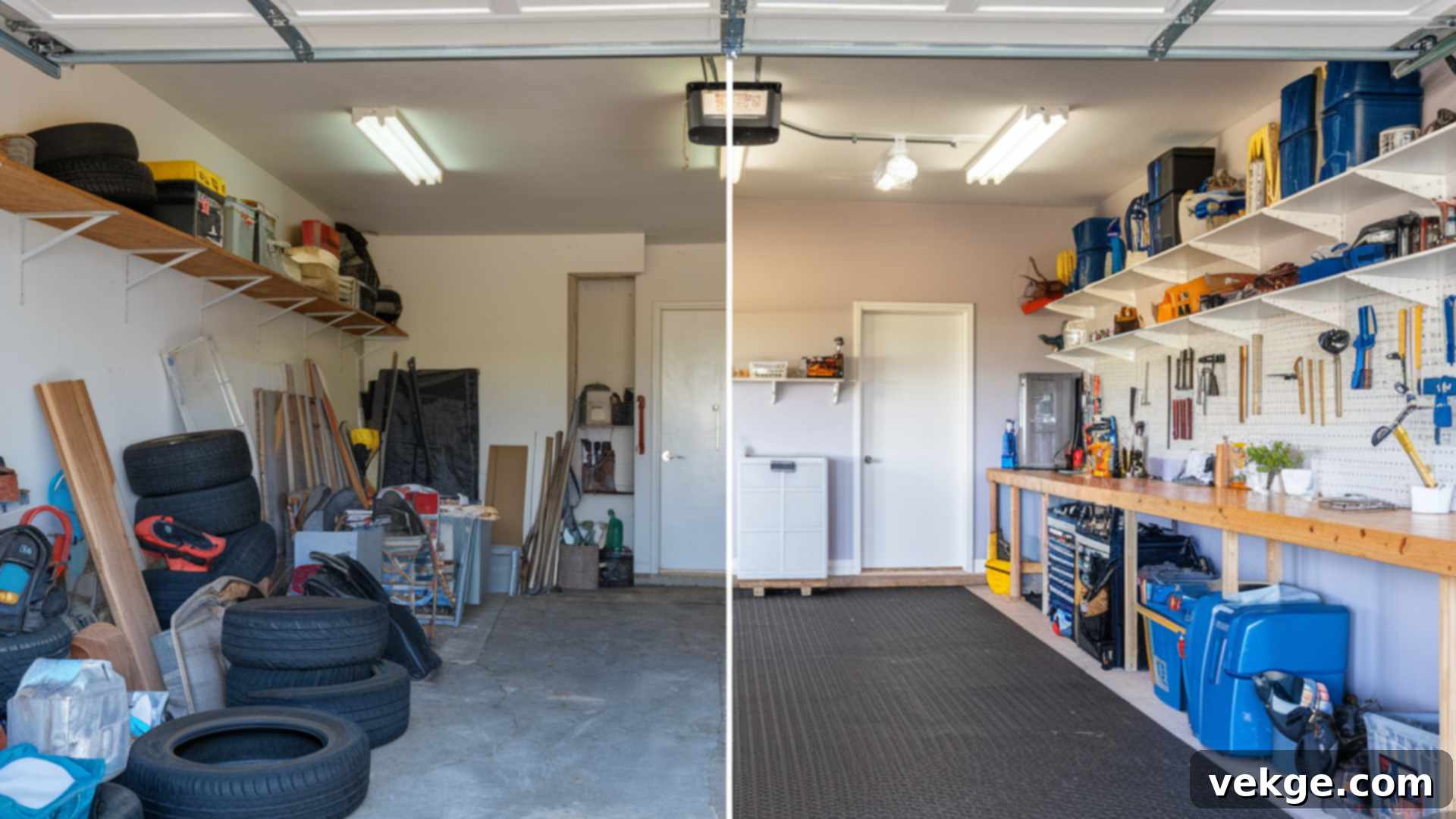
The garage and outdoor areas often become dumping grounds for forgotten items, making it difficult to find tools, park vehicles, or enjoy your yard. An organized garage or outdoor space greatly enhances functionality, making it easier to locate what you need and maintain overall property order. Use this comprehensive checklist to declutter and create a more efficient, clean, and accessible area:
- Clear the Floor Completely: Begin by removing all items from the garage floor. This includes large, unnecessary items like old furniture, broken appliances, discarded lumber, or unused large tools. This initial step provides a clean slate and allows you to move freely within the space.
- Sort Through Boxes and Bins: Go through every box and storage bin in your garage or outdoor storage area. Open each one and critically evaluate its contents. Donate, sell, or dispose of anything that is no longer useful, broken, or has been stored untouched for years.
- Organize Tools and Equipment: Group all your hand tools, power tools, gardening supplies, and outdoor equipment together. Invest in tool chests, pegboards, wall-mounted racks, or clearly labeled bins to store them efficiently. Ensure frequently used items are easily accessible.
- Check Seasonal Items: Review all seasonal items, such as holiday decorations, winter sports gear, summer camping equipment, or pool accessories. Keep only what you actively use and store these items in clearly labeled, weather-resistant containers in a designated area.
- Declutter Shelving Units and Cabinets: Go through any existing shelves, racks, or cabinets. Remove items you don’t need, such as old paint cans (dispose of properly!), empty boxes, or excess containers. Wipe down shelves and reorganize the remaining items logically.
- Inspect Outdoor Furniture and Décor: Clean and thoroughly check all your outdoor furniture, planters, and decorative items. Repair or dispose of any pieces that are worn out, broken, or beyond repair. Consider donating items you no longer use or want.
- Sort Through Sports Equipment & Outdoor Toys: Gather all bikes, scooters, sports balls, fishing gear, and outdoor toys. Donate or discard items that are damaged, outgrown, or no longer used. Store the remaining equipment neatly using hooks, racks, or large bins.
- Tidy Up the Garage Door Area: Ensure the area directly around and under the garage door is completely clear. This prevents obstructions and makes it easy to access the garage. Remove shoes, extra bikes, or tools that tend to accumulate near the entrance.
- Organize Cleaning Supplies and Car Care Products: Sort through any cleaning supplies, car waxes, or maintenance products stored in the garage. Dispose of empty bottles, expired liquids, or anything you no longer use, ensuring essentials are neatly stored and accessible.
- Perform a Final Clean-up and Sweep: After decluttering, give the entire garage floor a thorough sweep or vacuum. Wipe down any remaining surfaces, ensure everything has a designated spot, and walk through to confirm the space feels functional, safe, and completely clutter-free.
Decluttering Tips for Those with a Busy Schedule
For individuals with demanding schedules, finding dedicated blocks of time for decluttering can feel like an impossible feat. However, with a few smart and consistent strategies, you can steadily create a tidy, organized space without feeling overwhelmed or adding extra stress to your already packed life.
Start Small and Consistent: Instead of aiming for a marathon session, commit to just 10-15 minutes a day to tackle a very small, defined area. This could be a single drawer, a small section of a countertop, or just one shelf. This “micro-decluttering” approach builds momentum and prevents burnout, proving that small, consistent actions yield significant results over time.
Focus on One Area at a Time: Resist the urge to jump from room to room. Pick one specific drawer, shelf, or surface and focus exclusively on that area until it’s complete. Use the simple three-pile method: create distinct piles for “keep,” “donate/sell,” and “toss.” This focused approach prevents scatter-brained efforts and allows you to see tangible progress quickly.
Utilize Smart Storage Solutions: Once you’ve decided what to keep, invest in practical storage solutions like baskets, bins, or drawer dividers. These tools help maintain order and ensure that every item has a designated home, making future tidying much faster and easier.
Implement the “One In, One Out” Rule: To proactively prevent clutter from building up again, adopt the “One In, One Out” rule. Every time you bring something new into your home – whether it’s a piece of clothing, a kitchen gadget, or a book – commit to letting go of an existing, similar item. This simple habit maintains balance and keeps your possessions in check.
Schedule It In: Just like any other important appointment, schedule your short decluttering sessions into your calendar. Even if it’s just 10 minutes before dinner or after a specific daily task, treating it as an appointment increases the likelihood you’ll stick to it.
Remember, decluttering doesn’t demand perfection or immediate overhauls. Breaking it down into manageable tasks, utilizing a simple declutter checklist, and celebrating small victories makes it infinitely easier to stay on top of your home organization. With consistency and a positive mindset, you’ll achieve a more organized, peaceful space without the added stress!
Conclusion: Embrace the Calm of a Clutter-Free Life
The journey to a more organized and peaceful home is well within your reach, and utilizing a thoughtful decluttering checklist is your most effective tool. By breaking down seemingly daunting tasks into manageable steps, you can systematically tackle clutter in every corner of your home without succumbing to overwhelm.
Remember, even small, consistent efforts yield significant results. Just 10-15 minutes a day, focused on a specific area, can make a monumental difference over time. Take a moment to reflect on the areas in your home that most need attention, and begin applying the practical tips and comprehensive checklists we’ve covered here. As you diligently clear out what no longer serves your purpose or sparks joy, you will invariably create more physical and mental space for the things that truly matter in your life.
Embracing a decluttered lifestyle is not just about a tidy home; it’s about fostering clarity, reducing stress, and cultivating a sense of calm and control. If this guide has empowered you to start your decluttering journey, and you’re hungry for more insights and strategies, be sure to explore our other blogs for additional easy ways to stay organized and maintain your newly found peace.
